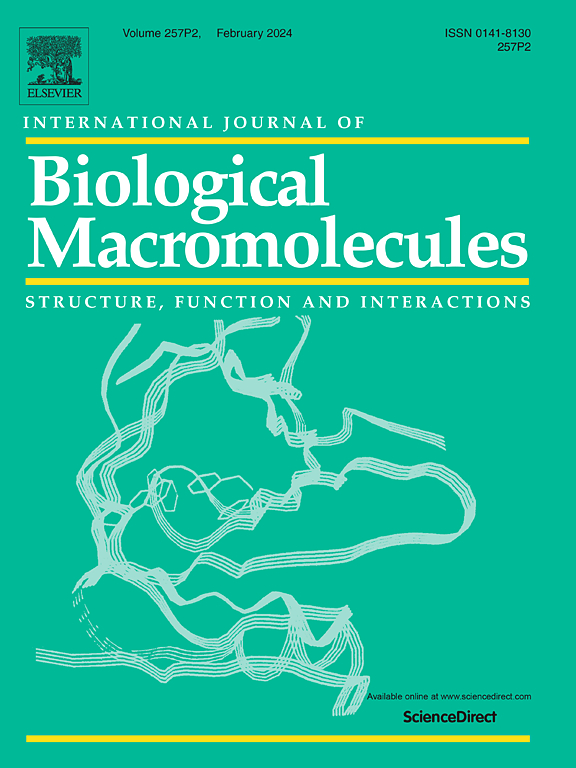血浆活化水(PAW)修饰pse样鸡分离蛋白:结构改变和增强成膜性能
IF 7.7
1区 化学
Q1 BIOCHEMISTRY & MOLECULAR BIOLOGY
International Journal of Biological Macromolecules
Pub Date : 2025-07-03
DOI:10.1016/j.ijbiomac.2025.145712
引用次数: 0
摘要
研究了血浆活化水(PAW)对热致碱性pse样鸡分离蛋白(PPI)的结构、氧化和成膜性能的影响。结果表明,随着制备时间的延长,木瓜中活性物质的含量显著增加。PAW处理导致PPI结构在成膜溶液中展开,表现为α-螺旋转化为β-片和β-转,暴露疏水基,表面疏水性增强,荧光强度显著降低。此外,PAW促进了PPI的氧化,表明总巯基含量降低,羰基含量大幅增加。对PPI薄膜的表征表明,PAW处理显著提高了其力学性能和亲水性,同时降低了其水蒸气渗透性。在各处理组中,PAW-90处理组拉伸性能最佳,水蒸气渗透性值(4.21±0.36 × 10−7 (g·m−1·h−1·kPa−1))和氧气渗透性值(7.45±0.84 × 10−8 (g·m−1·h−1·kPa−1))最低。主成分分析进一步揭示了PPI的分子结构与其成膜性能之间的相关性。综上所述,PAW可以诱导PPI分子结构的改变,从而改善其成膜性能。本文章由计算机程序翻译,如有差异,请以英文原文为准。
Plasma activated water (PAW) modification of PSE-like chicken protein isolate: Structural changes and enhanced film-forming properties
The oxidative effects of plasma-activated water (PAW) on the structure, oxidation, and film-forming properties of heat-induced alkaline PSE-like chicken protein isolate (PPI) were investigated. The results demonstrated that the content of active substances in PAW significantly increased with longer preparation times. PAW treatment led to the unfolding of PPI structure in the film-forming solution, evidenced by the conversion of α-helices to β-sheet and β-turn, exposure of hydrophobic groups, increased surface hydrophobicity, and a significant reduction in fluorescence intensity. Additionally, PAW facilitated the oxidation of PPI, as indicated by a decrease in total sulfhydryl content and a substantial increase in carbonyl content. Characterization of PPI films revealed that PAW treatment significantly enhanced their mechanical properties and hydrophilicity while reducing water vapor permeability. Among the treatment groups, the PAW-90 treatment group exhibited optimal tensile properties and the lowest water vapor permeability value (4.21 ± 0.36 × 10−7 (g·m−1·h−1·kPa−1)) and oxygen permeability value (7.45 ± 0.84 × 10−8 (g·m−1·h−1·kPa−1)). Principal component analysis further revealed the correlation between the molecular structure of PPI and its film-forming properties. In summary, PAW could induce alterations in the molecular structure of PPI, thereby improving its film-forming properties.
求助全文
通过发布文献求助,成功后即可免费获取论文全文。
去求助
来源期刊
CiteScore
13.70
自引率
9.80%
发文量
2728
审稿时长
64 days
期刊介绍:
The International Journal of Biological Macromolecules is a well-established international journal dedicated to research on the chemical and biological aspects of natural macromolecules. Focusing on proteins, macromolecular carbohydrates, glycoproteins, proteoglycans, lignins, biological poly-acids, and nucleic acids, the journal presents the latest findings in molecular structure, properties, biological activities, interactions, modifications, and functional properties. Papers must offer new and novel insights, encompassing related model systems, structural conformational studies, theoretical developments, and analytical techniques. Each paper is required to primarily focus on at least one named biological macromolecule, reflected in the title, abstract, and text.

 求助内容:
求助内容: 应助结果提醒方式:
应助结果提醒方式:


